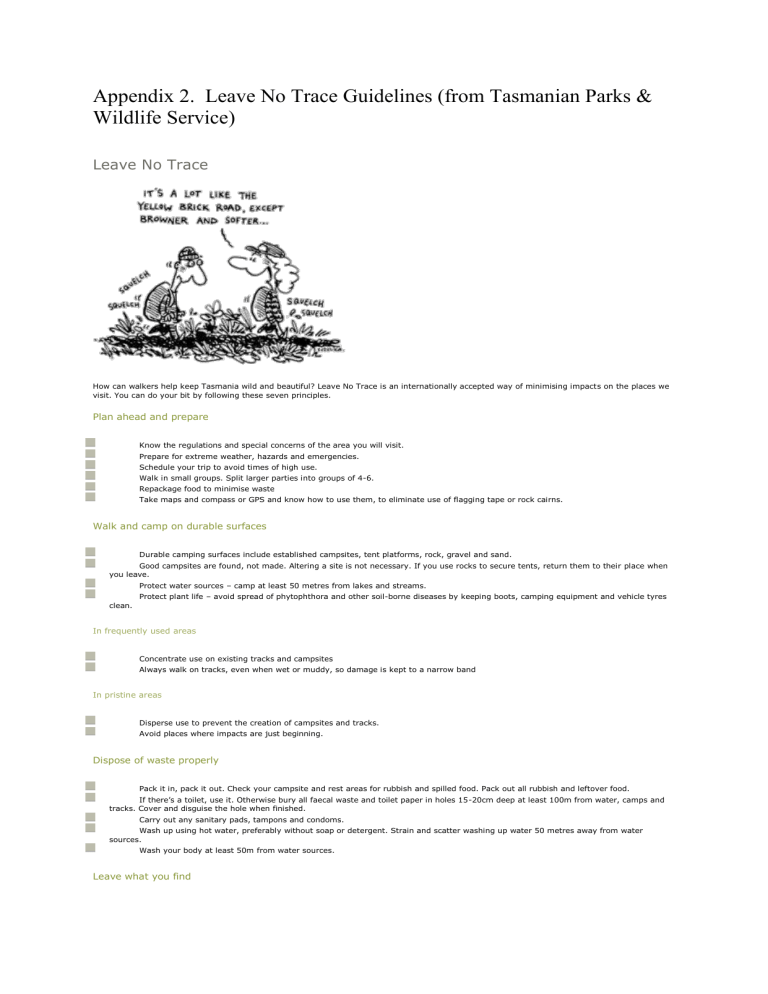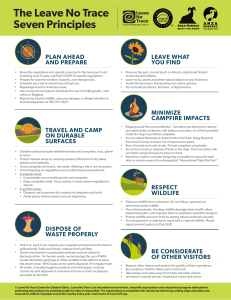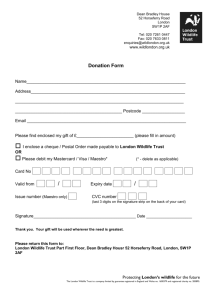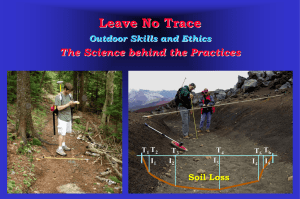Appendix 2

Appendix 2. Leave No Trace Guidelines (from Tasmanian Parks &
Wildlife Service)
Leave No Trace
How can walkers help keep Tasmania wild and beautiful? Leave No Trace is an internationally accepted way of minimising impacts on the places we visit. You can do your bit by following these seven principles.
Plan ahead and prepare
Know the regulations and special concerns of the area you will visit.
Prepare for extreme weather, hazards and emergencies.
Schedule your trip to avoid times of high use.
Walk in small groups. Split larger parties into groups of 4-6.
Repackage food to minimise waste
Take maps and compass or GPS and know how to use them, to eliminate use of flagging tape or rock cairns.
Walk and camp on durable surfaces
Durable camping surfaces include established campsites, tent platforms, rock, gravel and sand.
Good campsites are found, not made. Altering a site is not necessary. If you use rocks to secure tents, return them to their place when you leave.
Protect water sources – camp at least 50 metres from lakes and streams. clean.
Protect plant life – avoid spread of phytophthora and other soil-borne diseases by keeping boots, camping equipment and vehicle tyres
In frequently used areas
Concentrate use on existing tracks and campsites
Always walk on tracks, even when wet or muddy, so damage is kept to a narrow band
In pristine areas
Disperse use to prevent the creation of campsites and tracks.
Avoid places where impacts are just beginning.
Dispose of waste properly
Pack it in, pack it out. Check your campsite and rest areas for rubbish and spilled food. Pack out all rubbish and leftover food.
If there’s a toilet, use it. Otherwise bury all faecal waste and toilet paper in holes 15-20cm deep at least 100m from water, camps and tracks. Cover and disguise the hole when finished.
Carry out any sanitary pads, tampons and condoms.
Wash up using hot water, preferably without soap or detergent. Strain and scatter washing up water 50 metres away from water sources.
Wash your body at least 50m from water sources.
Leave what you find
Respect Aboriginal sites and other sites of cultural significance.
Preserve our past: examine but don’t touch cultural or historic structures and artefacts.
Leave rocks, plants and other natural objects as you find them.
Minimise campfire impacts – use a fuel stove
Many parts of Tasmania are Fuel Stove Only Areas. In these areas fires are not permitted. Carry and use a fuel stove.
Out of preference, use fuel stoves even where fires are permitted. Escaped campfires have caused landscape wide damage, and can threaten human life as well as plants and animals.
If lighting a fire (where permitted) use only established fire places and keep the fire small.
Respect wildlife
Keep wildlife wild. Feeding animals can turn them into pests and may make them sick.
Store food and rubbish securely to discourage wildlife from finding it.
Observe wildlife from a distance. Do not follow or approach wildlife.
Be considerate of your hosts and other visitors
Respect Aboriginal culture and country.
Respect the wishes and regulations of all hosts (eg Aboriginal, pastoral, land managers and locals).
Only visit places where you have obtained appropriate permission.
Respect other visitors and protect the quality of their experience.
Let natural sounds prevail – avoid loud voices and noises.











